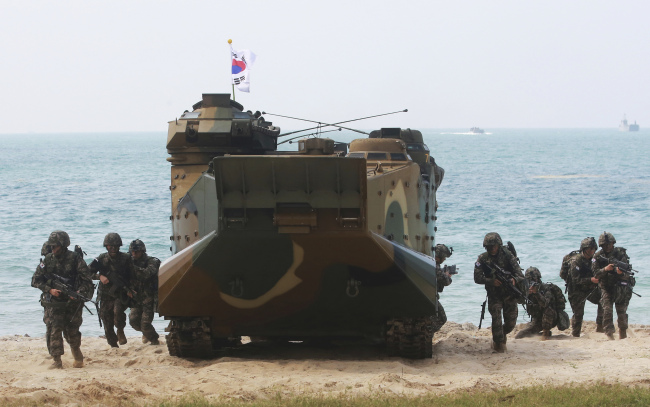With the South Korean military participating in a multilateral amphibious landing drill in Southeast Asia over the weekend, speculation continues to rise over when South Korea and the US will resume their annual joint drills on the Korean Peninsula.
The troops from the South Korean Navy and Marine Forces on Saturday joined US Marines and the Thai Royal Navy in eastern Thailand, where the annual Cobra Gold exercise is being held. The exercise kicked off on Feb. 13 and will continue until Friday.
A total 430 sailors and marines are expected to be dispatched along with battle amphibious landing ships such as Cheon Ja Bong, South Korea’s Marine Forces said. It was to conduct a joint exercise with the US amphibious assault ship USS Bonhomme Richard.
“Cobra Gold exercise is part of multinational peacekeeping operation to enhance international cooperation on disaster relief amid changes in the regional security environment,” said Col. Lee Hong-jung, who leads a marine unit participating in the exercise.
 |
South Korean soldiers jump off an amphibious assault vehicle after hitting the ground during the ongoing Cobra Gold US-Thai joint military exercise on Hat Yao beach in Chonburi province, eastern Thailand, Saturday. AP-Yonhap |
While South Korea and the US participate in the largest multinational military exercise in Southeast Asia, the allies’ militaries have remained mum about the timeline and scope of their annual Foal Eagle and Key Resolve exercises.
Speculation has been rampant that the 2018 drill would kick off in April on a similar scale to that of last year, with the field training exercise Foal Eagle kicking off on April 1, followed three weeks later by the computerized command post exercise Key Resolve.
While the allies’ militaries have reiterated the annual exercise would resume upon the conclusion of the Olympics and Paralympics in March, some experts suspect the drill could be scaled down in return for North Korea’s moratorium on missile and nuclear tests.
“As a practical matter, there is a variety of adjustments that might be made to joint military exercises. For instance, strategic bombers are deemed by (the North) to be provocative,” Patrick Cronin, senior director of the Asia Program at the Center for a New American Security, told The Korea Herald.
But the US expert added that the measure can be considered only after the North suspends its nuclear and missiles tests until after the Olympics. The last time North Korea conducted such tests was Nov. 29 when it fired off an ICBM-class Hwasong-15 capable of reaching the US mainland.
Last year’s Foal Eagle and Key Resolve exercises were considered to be the largest ever, involving about 300,000 troops and the US strategic assets. Among them were F-35B stealth fighters and the USS Carl Vinson, a nuclear-powered aircraft carrier.
North Korea’s state-run newspaper Rodong Sinmun on Monday ratcheted up its criticism against the annual drill, denouncing it for escalation tensions on the Korean Peninsula amid Olympic detente between the two Koreas.
“There are ominous signs showing up,” the newspaper said in an editorial. “Vast number of strategic assets and troops are coming to the peninsula.”
By Yeo Jun-suk(
jasonyeo@heraldcorp.com)








